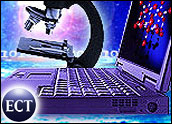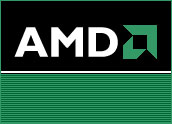
Hewlett-Packard on Monday revealed a miniature wireless high-storage data chip that potentially could compete with RFID technology in the enterprise space and with Bluetooth in the consumer arena.
The Memory Spot chip is roughly the size of a grain of rice with a built-in antenna and is based on CMOs — a widely used, low-power integrated circuit design. The chips could be embedded in a sheet of paper or stuck to any surface, and eventually could be available in a booklet as self-adhesive dots, according to the company.
The chip has a 10 megabits-per-second data transfer rate — which HP says is 10 times faster than Bluetooth wireless technology and comparable to WiFi speeds. Storage capacity ranges from 256 kilobits to 4 megabits in working prototypes, which HP says enables it to store a very short video clip, several images or dozens of pages of text. Future versions could have larger capacities.
“The Memory Spot chip frees digital content from the electronic world of the PC and the Internet and arranges it all around us in our physical world,” said Ed McDonnell, Memory Spot project manager, HP Labs.
Addressing Consumers
The first addressable market for this product likely will be consumers looking to share entertainment via cell phones, predicts Ellen Daley, vice president and research director at Forrester.
That is where Bluetooth might face some competition.
“We can’t forget the ubiquity that Bluetooth is experiencing now, ” Daley told TechNewsWorld. “This new technology would have to get as cost-competitive, technology mature and justify rationale to change — and that does not exist today.”
On the other hand, Bluetooth predominantly serves as a short-range wireless technology with no storage capabilities, she said.
HP is far from putting all its eggs in one basket when it comes to Memory Spot, however.
No product plans are in place right now, but the company is exploring a range of possibilities, Howard Taub, vice president and associate director at HP Labs, told TechNewsWorld. “An area of particular interest to us is the possibility of putting audio on photos. That really enhances the experience,” he said. For example, instead of just sending a birthday card from a young child to her grandmother, the girl can give her a verbal message.
Other opportunities include storing medical records on a hospital patient’s wristband, helping fight counterfeiting in the pharmaceutical industry, adding security to identity cards and passports and providing audio-visual supplements to postcards and photos, the company said.
Challenging RFID
Focusing on anti-counterfeiting tags, HP said Memory Sport chips can contain secure information about the manufacture and quality of pharmaceuticals. “When added to a drug container, this can prove their authenticity,” the company said. “A similar process could be used to verify high-value engineering and aviation components.”
Daley sees the potential for high-storage capability in the health space, where RFID technology is widespread. She cautioned, however that even RFID has not been “taking off like gangbusters” in this sector, predominately because of the challenge of solving business problems cost effectively.
“Many folks will say the challenge for RFID has been the technology and cost, but our data shows the business case as being a huge inhibitor,” Daley said. “I think similarly for [Memory Spot]. I suspect it will be much more interesting in the consumer space, but the cost has to get down very low. … I’m dubious about the success of this in two years. I think it will take longer.”
Taub insisted that Memory Spot is not meant to compete with RFID, but rather to complement it. The information with this new technology is all stored on the chip itself, rather than in a large database, plus the chip is much smaller and has much greater capacity than RFID, Taub said. “It’s a whole new space.”





















































